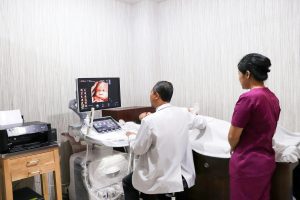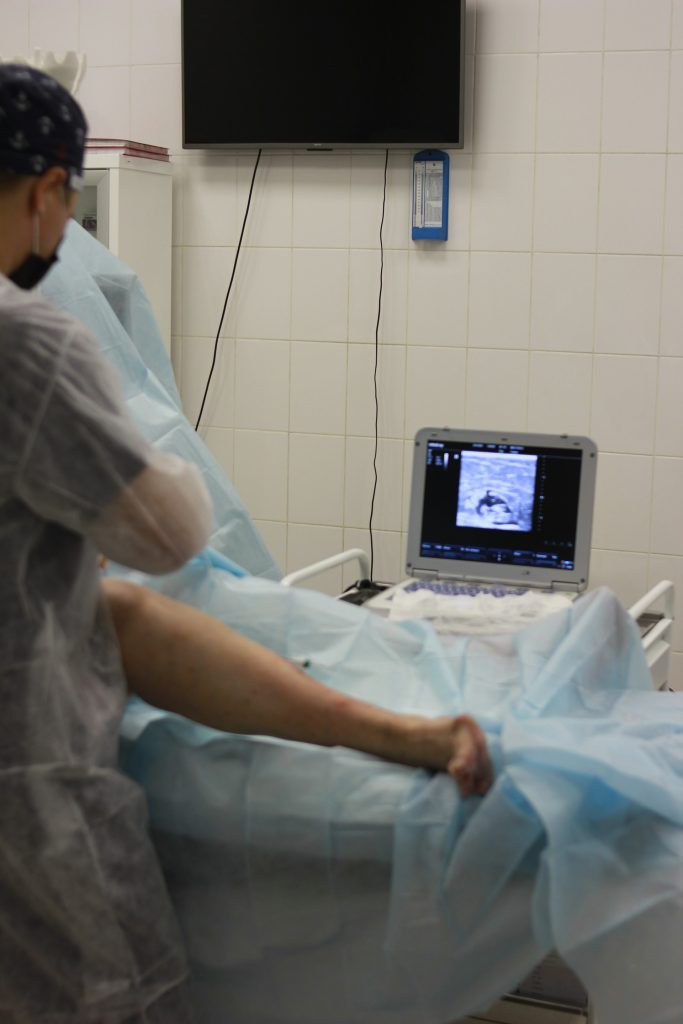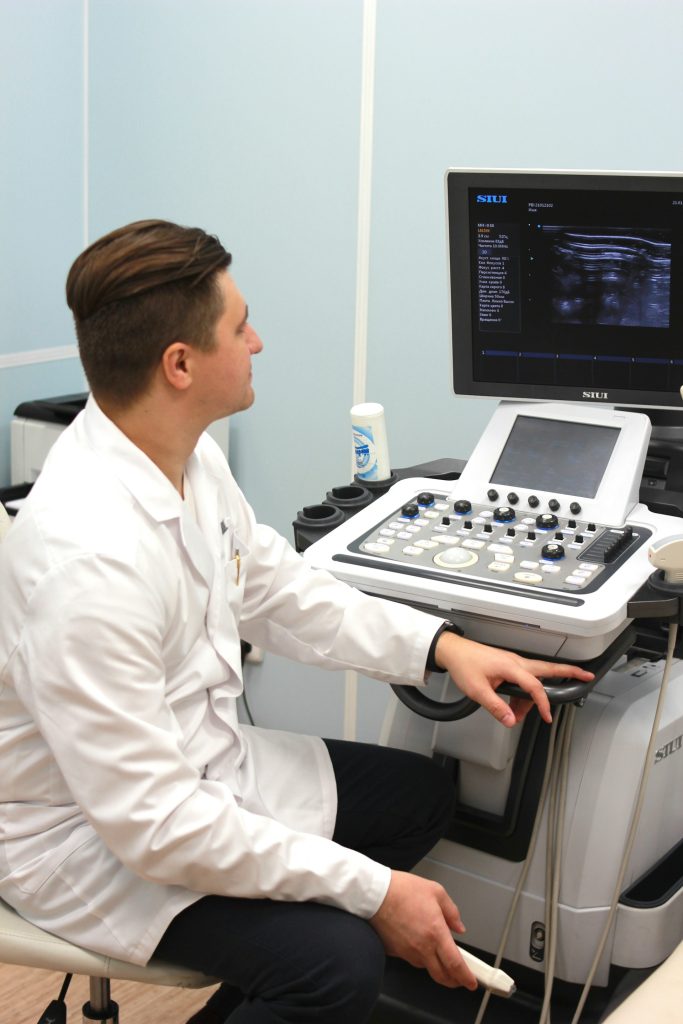 A diagnostic medical sonographer, commonly referred to as a sonographer, creates ultrasound images of various bodily parts using imaging technology and sound waves. They have received training in obtaining and evaluating these sonographic pictures. Doctors use these pictures to diagnose and treat a variety of illnesses. Ultrasound is frequently the first imaging test carried out when a disease is discovered because it is a non-invasive method of seeing inside organs. As a result, diagnostic medical sonographers play a crucial role in performing and interpreting preliminary imaging tests that may help refine a patient’s diagnosis and expedite the delivery of necessary care.
A diagnostic medical sonographer, commonly referred to as a sonographer, creates ultrasound images of various bodily parts using imaging technology and sound waves. They have received training in obtaining and evaluating these sonographic pictures. Doctors use these pictures to diagnose and treat a variety of illnesses. Ultrasound is frequently the first imaging test carried out when a disease is discovered because it is a non-invasive method of seeing inside organs. As a result, diagnostic medical sonographers play a crucial role in performing and interpreting preliminary imaging tests that may help refine a patient’s diagnosis and expedite the delivery of necessary care.
Read Also: Pharmaceutical Sales Jobs in the USA
What to Know About Diagnostic Medical Sonographer Jobs in the USA
 Operating imaging equipment and evaluating images to ensure they are high-quality and useful for diagnosis are typical work duties, roles, and obligations of a diagnostic medical sonographer. They are responsible for recognizing normal and abnormal imaging data, summarizing the findings for doctors or other medical experts, and informing doctors of critical issues. Also, they handle patient education during the ultrasonography examination and procedure preparation. Diagnostic medical sonographers examine a patient’s medical history, documenting imaging findings in patient records, and coordinating treatment with different hospital or clinic departments.
Operating imaging equipment and evaluating images to ensure they are high-quality and useful for diagnosis are typical work duties, roles, and obligations of a diagnostic medical sonographer. They are responsible for recognizing normal and abnormal imaging data, summarizing the findings for doctors or other medical experts, and informing doctors of critical issues. Also, they handle patient education during the ultrasonography examination and procedure preparation. Diagnostic medical sonographers examine a patient’s medical history, documenting imaging findings in patient records, and coordinating treatment with different hospital or clinic departments.
Physicians, nurses, and patients of all ages—from young children to the elderly—all collaborate with diagnostic medical sonographers. Radiation technologists and magnetic resonance imaging technicians perform similar duties in diagnostic imaging, helping to perform and analyze X-rays and MRIs, respectively.
-
Expertise
Numerous specializations are available for diagnostic medical sonographers. For instance, obstetric and gynecologic sonographers specialize in imaging the female reproductive system, whereas vascular technologists provide images of blood arteries. Other specialized sonographers can concentrate on imaging the blood vessels, musculoskeletal system, or abdomen. An echocardiographer is a sonographer who specializes in imaging the heart; they visualize patients’ cardiac arteries and heart valves. Many general sonographer positions will require imaging knowledge in multiple fields, even though some employers would prefer specialized sonographers.
-
Workplace
In addition to working with imaging equipment in a special area within the hospital or clinic, diagnostic medical sonographers are frequently seen doing ultrasound operations at a patient’s bedside. The majority of diagnostic medical sonographers work full-time, although depending on their employment, some may be required to work weekends, holidays, or evenings. The position frequently necessitates standing for the majority of the workday.
Diagnostic medical sonographers are primarily employed in hospitals, but they can also work in medical and diagnostic labs and doctors’ offices. Whether you work in a hospital, clinic, or specialized lab, a diagnostic medical sonographer’s duties usually don’t change all that much. However, if you work for a large hospital or health system, you may meet a wide range of illness conditions or be able to specialize.
Read Also: Medical Billing and Coding Jobs Paying $122,000 in the USA
What is the Job Outlook for Sonographers Right Now?
 Sonographers, commonly referred to as ultrasound technologists or diagnostic medical sonographers, have a very bright future. Sonographers with the necessary skills are in high demand. The employment of diagnostic medical sonographers is expected to increase by 14% between 2020 and 2030, which is much faster than the average for all occupations, according to the U.S. Bureau of Labor Statistics (BLS). An aging population, rising prevalence of chronic illnesses including diabetes and heart disease, and increased use of sonography imaging as a diagnostic and screening tool are all factors contributing to this trend.
Sonographers, commonly referred to as ultrasound technologists or diagnostic medical sonographers, have a very bright future. Sonographers with the necessary skills are in high demand. The employment of diagnostic medical sonographers is expected to increase by 14% between 2020 and 2030, which is much faster than the average for all occupations, according to the U.S. Bureau of Labor Statistics (BLS). An aging population, rising prevalence of chronic illnesses including diabetes and heart disease, and increased use of sonography imaging as a diagnostic and screening tool are all factors contributing to this trend.
The job market for certified sonographers is improving due to a number of variables. As the population ages, more diagnostic imaging tests are required to identify health issues in elderly patients. Sonography is also being used more frequently to detect problems in pregnant individuals and evaluate the health of fetal development. The need for sonography services for continuous patient monitoring and treatment planning is further increased by the rising prevalence of chronic illnesses. Sonographers will still find the most employment at hospitals and specialized imaging facilities, but more chances are opening up in doctors’ offices and clinics. Patients can be imaged and diagnosed in the same place when ultrasound technology is available in these settings. Strong demand and promising career prospects for qualified sonographers entering the sector are indicated by the overall favorable job growth estimates.
Sonographers are receiving competitive pay, benefits, and perks as a result of this high demand. Those with knowledge and good qualifications can bargain for higher pay. The median salary for healthcare support jobs is lower than that of diagnostic medical sonographers. The average yearly pay for an ultrasound technologist was $77,090 in 2021, according to BLS data.
Read Also: Surgical Technologist Jobs in the USA Paying $134,000 Yearly
Diagnostic Medical Sonographer Jobs in the USA- How to Start
 Loving anatomy, being meticulous, paying close attention to imaging procedures, and having a sharp eye for minute variations in imaging results are all beneficial for being a competent medical diagnostic sonographer. Working with a variety of patient populations and effectively conveying imaging results to other medical professionals requires interpersonal skills. For those who wish to acquire highly technical abilities while working closely with people daily, a career as a medical diagnostic sonographer can be a good choice. The role requires a combination of hand-eye coordination, specialized medical knowledge, and a drive to provide patients with the care they require.
Loving anatomy, being meticulous, paying close attention to imaging procedures, and having a sharp eye for minute variations in imaging results are all beneficial for being a competent medical diagnostic sonographer. Working with a variety of patient populations and effectively conveying imaging results to other medical professionals requires interpersonal skills. For those who wish to acquire highly technical abilities while working closely with people daily, a career as a medical diagnostic sonographer can be a good choice. The role requires a combination of hand-eye coordination, specialized medical knowledge, and a drive to provide patients with the care they require.
-
Higher education requirements
To become a diagnostic medical sonographer, there are numerous educational options. Obtaining an associate’s or bachelor’s degree with coursework in the sciences and anatomy is the standard route after high school. Completing a diagnostic medical sonography certificate program is important. Certificate programs include both clinical experiences and educational courses tailored to diagnostic medical sonography training. Colleges, universities, and teaching hospitals offer certificate programs.
-
Certifications for Diagnostic Medical Sonographers
A professional sonography certification and basic life support training are also requirements from many employers. Candidates must obtain certification shortly after getting a job. Sonographers can become certified by a number of organizations, such as the American Registry of Radiologic Technologists, Cardiovascular Credentialing International, and the American Registry for Diagnostic Medical Sonographers (ARDMS). The majority of certified diagnostic medical sonographers will work as registered diagnostic medical sonographers (R.D.M.S.), while some will also obtain advanced qualifications.
Read Also: Outdoor Jobs in the USA- Everything You Need to Know
What Are The Challenges?
Due to the rigorous nature of their employment, sonographer burnout is becoming a concerning reality. They deal with the emotional strain of breaking bad news to patients daily, frequently leaving them with little time to heal before taking on the next case. They find it more difficult to maintain their well-being as a result of long shifts and high-stress workplaces. It’s critical to comprehend the underlying issues to remedy this. The following are the main risk factors that lead to sonographer burnout:
-
Exhaustion and a Heavy Workload
Every day, sonographers deal with a growing number of tests and assignments. A large portion of their time is spent on unnecessary administrative tasks rather than patient care. This is because they have more appointments in their schedules. It is challenging for them to give patients the individualized treatment they need because of this move away from meaningful patient care and toward paperwork and mundane activities. Over time, this stress has an impact on their health and job satisfaction, making it more difficult for them to remain motivated and involved in their work.
This burden can be lessened with the use of ultrasound reporting software. It has features that simplify administrative work, relieving sonographers of time-consuming, low-value chores. Sonographers can concentrate more on patient care and give them individualized attention by automating tasks like reporting and paperwork, which improves patient outcomes and increases job satisfaction.
Read Also: X-ray Tech Jobs in the USA
-
Sonographers’ Emotional Burnout
Sonographers deal with compassion fatigue, a form of secondary traumatic stress. In fact, their profession frequently exposes them to the misery and suffering of patients, which can negatively impact their mental health. Sonographers’ mental health may suffer greatly as a result of the ongoing emotional strain of seeing and understanding patients’ struggles. Burnout, anxiety, depression, and even post-traumatic stress disorder (PTSD) can result from this accumulating stress over time. It’s critical to acknowledge that sonographers frequently experience compassion fatigue and to put procedures in place to alleviate and lessen its effects. Promoting sonographers’ mental health requires offering opportunities for self-care and debriefing, as well as resources for coping.
Healthcare companies could provide robust support to combat compassion fatigue. Sonographers can better handle the emotional demands of their jobs if they have access to treatment, particularly trauma-informed psychotherapy. Mental health programs and regular debriefings following difficult cases might also reduce their emotional burden.
-
Unhappiness and Career Stagnation
Many sonographers feel stuck in their profession because there are few prospects for career progression in the area. It can be discouraging to experience this lack of upward mobility. Sonographers may be unsure of their future in the field if they don’t have a clear career route to follow.
Additionally, burnout among sonographers may increase due to a lack of career advancement prospects. A sense of stagnation and discontent might result from working in a position with no opportunities for advancement. This can therefore have a detrimental effect on their general well-being and job performance. When sonographers do not perceive a clear path for advancement, they may become disengaged and less committed to their jobs. They may thus have lower job satisfaction and a higher chance of burnout.
By taking part in studies run by academic institutions or healthcare organizations, sonographers can improve their abilities and advance their careers. They can improve their knowledge and establish themselves as important contributors in their field by participating in research collaborations.
-
Feeling Unappreciated
Sonographers frequently feel ignored and undervalued while playing a vital role in the medical industry. Even though they are crucial to precise diagnosis and treatment choices, their contributions are often overlooked. Their self-esteem and morale may suffer significantly as a result of this lack of recognition. Sonographers may become less confident and valuable members of the healthcare team if they don’t get the credit they deserve. They can become frustrated and disillusioned if they believe that their efforts are not valued.
By identifying and rewarding high-performing sonographers, healthcare organizations can improve morale, increase work satisfaction, and cultivate a sense of gratitude within their teams. The option of developing a bonus and incentive program is possible by Sonio’s practice analytics and automatic quality control, which may supply the information required to identify such top achievers (for instance, sonographers whose exams routinely satisfy quality criteria).
-
Sonography Workplace Satisfaction and Environment
Sonographers’ job happiness is significantly impacted by the quality of their workplace. Sustaining high levels of job satisfaction requires a secure and encouraging work environment. However, a lot of sonographers work in environments that have toxic leadership, inadequate organizational structure, and volatility. These unfavorable circumstances may lead to a disorganized workplace. This makes it challenging for sonographers to carry out their responsibilities efficiently and cheerfully.
Sonographers’ motivation and dedication to their work may be weakened if they feel underappreciated and unsupported. Job satisfaction further decreases from a poor work-life balance. This is frequently brought on by long hours and a heavy workload. Sonographers are more prone to stress and burnout when they are unable to successfully manage their personal and professional life. A concentrated effort to enhance work-life balance programs, leadership styles, and organizational culture is needed to address these problems.
-
Sonographers’ Physical Stress and Fatigue
Because of the physical demands of their employment, sonographers are particularly vulnerable to work-related musculoskeletal diseases (WRMSDs). Chronic ailments, including tendinitis, back pain, and carpal tunnel syndrome, are examples of these maladies. Muscles and joints can strain from postures and repetitive actions needed for scanning processes. Over time, this may result in physical limits and chronic discomfort. Also, it can impact both their quality of life and their ability to perform at work.
Sonographers frequently suffer from eye strain from prolonged screen and monitor attention in addition to musculoskeletal problems. Headaches, blurred vision, and general visual tiredness may follow from this. Because pain and exhaustion can result in lower productivity and higher levels of frustration, these physical ailments add to a vicious cycle of misery and stress. Burnout risk can increase due to the ongoing struggle with physical pain. This can also lead to mental and emotional tiredness. To reduce these dangers and promote the physical well-being of sonographers, effective ergonomic treatments and frequent breaks are crucial.
-
Stress and Performance Pressure
The sonographer’s ability and accuracy have a significant impact on the quality of ultrasound tests. Sonographers are under a lot of pressure to continuously produce excellent findings because of this operator dependency. It may be overwhelming to execute flawlessly, especially when there are a lot of patients and time restrictions. Because precise diagnoses are crucial and every mistake can have detrimental effects on patient care, this pressure increases.
Sonographers may feel anxious and self-conscious, especially if they don’t think they can live up to these high standards. Sonographers must focus and be attentive throughout every test. This can cause mental exhaustion due to the ongoing need for alertness and accuracy. Burnout may eventually result from the constant pressure to perform at your best. Ongoing training, sufficient staffing numbers, and a positive work atmosphere that recognizes and tackles the difficulties of operator dependency are essential to helping sonographers manage these demands.
These days, ultrasound reporting software provides real-time assistance. It automatically monitors the views needed for an exam based on research procedures that can be customized (e.g., first trimester, detailed, basic). Sonographers can monitor exam progress and completion in real time thanks to AI technology. It refreshes a checklist of views as photos are received from the ultrasound equipment. Sonographers’ stress levels are reduced through automatic quality criterion checking. This guarantees accuracy and helps them better handle the demands of their jobs.
Read Also: Best Grants for College in the USA
Conclusion
A career as a diagnostic medical sonographer offers job security and a competitive salary. With the projected growth in this industry, now is the best time to start a career in the field. The combination of technical expertise, patient interaction, and critical diagnostic contribution makes this one of the most fulfilling careers in medical imaging. Also, it is important to enter the field with realistic expectations. While the rewards are substantial, sonographers face real challenges, including physical demands, emotional stress, and heavy workloads. Understanding these obstacles up front helps you prepare mentally and physically for a sustainable career.
